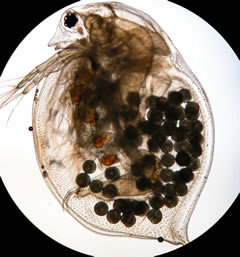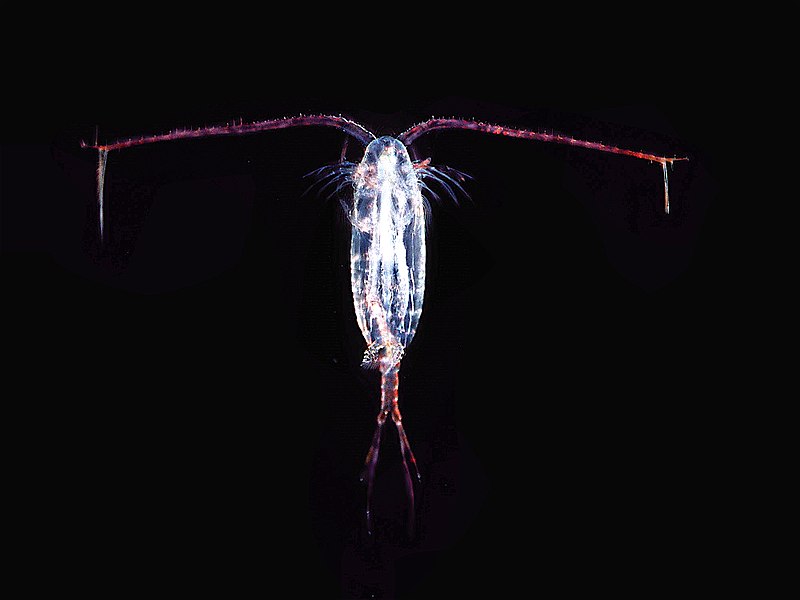 Hello, Frank Indiviglio here. There was a time when all serious aquarists maintained live cultures of Daphnia. This practice has fallen out of favor today, with live foods being replaced by prepared diets. However, many tiny aquatic Crustaceans are easy (and interesting!) to maintain, and represent one of the most nutritious of all food sources for aquatic animals.
Hello, Frank Indiviglio here. There was a time when all serious aquarists maintained live cultures of Daphnia. This practice has fallen out of favor today, with live foods being replaced by prepared diets. However, many tiny aquatic Crustaceans are easy (and interesting!) to maintain, and represent one of the most nutritious of all food sources for aquatic animals.
The animals highlighted here are especially valuable for fry and small or filter-feeding invertebrates, and are essential to the survival of tiny live food specialists such as seahorses and pipefishes. They can be used for freshwater or marine animals. Be aware, however, that freshwater species will expire rapidly in salt water, and vice-versa.
Daphnia
These tiny Crustaceans may easily be collected via plankton net (available at biological supply houses) from nearly any body of fresh water. Alternatively, a culture may set up by adding pond water and grass or hay to a tank placed in a sunny location (or use a full spectrum bulb).
Eggs or immature Daphnia magna, a very common species, will likely be present and, at 75-80 F, will mature within a week. This species reaches 0.25 inches in length (a Daphnia giant!) and is sometimes available commercially. Females produce 100 or more eggs every few days (with or without males), and so a healthy colony will easily meet the needs of most aquarists.
Daphnia fare best in tanks supporting a healthy growth of algae. While filtration is not essential, I’ve found a sponge filter
to be very beneficial (use a small air pump – strong currents should be avoided).
Decaying plant matter provides sufficient food, but growth and reproduction will be hastened if you supplement the culture with Artemia food , ground Spirulina discs and liquid invertebrate foods.
Copepods
 Smaller even than most Daphnia, Copepods are an excellent food source for the tiniest of fish fry, shrimps and filter-feeding invertebrates. I’ve used them for dwarf seahorses and newborn four-spine sticklebacks with great results.
Smaller even than most Daphnia, Copepods are an excellent food source for the tiniest of fish fry, shrimps and filter-feeding invertebrates. I’ve used them for dwarf seahorses and newborn four-spine sticklebacks with great results.
Occurring in fresh and marine waters worldwide, over 5,000 species of these crustaceans have been described to date (Copepod taxonomists must be quite amazing people!). Cyclops fuscus, which reaches 0.124 inches in length, is the species most commonly encountered in the USA.
Copepods may be collected and raised as described for Daphnia.
Seed Shrimp or Ostracods
These aptly-named Crustaceans (Class Ostracoda) do indeed resemble tiny shrimps encased within a seed. The 13,000+ described species thrive in a nearly every aquatic habitat known, from the deepest oceans to the few drops of rainwater that collects in bromeliads growing in rainforest canopies. They are truly amazing in their range of forms and adaptations.
Seed shrimps “bounce” along the substrate, a habit that renders them an ideal food for bottom-dwelling aquarium pets. Although rarely cultured for food, I have found them to be quite hardy, and well worth the small effort involved in keeping them. Their exoskeleton is an excellent source of calcium.
Seed shrimp care is as described for Daphnia.
Useful Products
A number of highly nutritious crustacean-based foods are available to supplement live-food diets. The following are well-worth trying:
Further Reading
Despite their small size, seed shrimps are incredibly complicated creatures, and quite interesting in their own right. Read more about their structure and behavior at http://w3.gre.ac.uk/schools/nri/earth/ostracod/introduction.htm.
Please write in with your questions and comments. Thanks, until next time, Frank Indiviglio.
Copepod image referenced from Wikipedia and originally posted by Uwe Kils
 That Fish Blog – Aquarium Advice and Information
That Fish Blog – Aquarium Advice and Information


What kind of nutritional value do seed shrimp have? I want to use them as food but they seem to be mostly shell.
Hi Donovan, Most small shrimp like those aren’t going to have much nutritional value on their own. It is always a good idea to gut-load them with something more nutritious before you use them as food. Since Seed Shrimp are so small, planktonic foods like phytoplankton or zooplankton or crushed flake foods would be suitable. You can read more on gut-loading in our blog Live Feeders: Gut Loading for Aquarium Predators.
Great write up on seed shrimp, wonder if seed shrimp could be an alternate food source for discus fry instead of just brine shrimp?